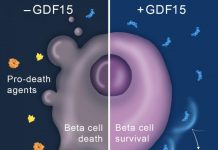A simple blood test could determine whether older women with diabetes would benefit from--or be harmed by--vitamin doses designed to protect their ailing hearts, according to researchers at the Technion-Israel Institute of Technology.
The test screens for genetic variations in a blood protein called haptoglobin. Diabetic, post-menopausal women who carry two copies of the variation known as haptoglobin-2 increase their risk of atherosclerosis, or narrowed arteries, if they take doses of the antioxidant vitamins C and E, Dr. Andrew P. Levy of the Faculty of Medicine says.
In contrast, diabetic women who carry two copies of haptoglobin-1 seem to have a decreased rate of atherosclerosis when they take the vitamins, Levy and colleagues found. Their research appears in the April 2004 issue of Diabetes Care.
"This study says that you can find subgroups of people who actually might benefit and subgroups which will actually be harmed by antioxidant vitamins, so it is important to know which haptoglobin type you are," Levy says.
Although there is a commercial test for haptoglobin type, the test is not widely used, according to Levy.
Continue Reading Below ↓↓↓
The new research may help clear up some of the controversy surrounding the use of antioxidant vitamins in patients with heart disease. Some previous studies suggest that antioxidant doses can prevent the progress of atherosclerosis, while the majority of studies have shown there is no benefit from taking antioxidants. Other studies suggest that the vitamins can actually speed up the course of heart disease by interfering with blood cholesterol levels and the effect of cholesterol lowering drugs.
Levy and colleagues examined the effects of antioxidants in 299 post-menopausal women with at least partial blockage in one coronary artery. Women in the study were randomly assigned to take either 400 IU of vitamin E and 500 milligrams of vitamin C twice a day or placebo pills.
The effects of the vitamin therapy differed depending on the women's haptoglobin type.
The researchers found that a three-year course of vitamin therapy slowed down atherosclerosis in women with a pair of haptoglobin-1 genes. The beneficial combination of haptoglobin-1 and antioxidants was especially marked in women with diabetes.
More ominously, antioxidants seemed to accelerate artery narrowing in diabetic women carrying a pair of haptoglobin-2 genes. Women without diabetes, however, experienced no negative effects from the antioxidants even if they carried a double dose of haptoglobin-2.
Why would haptoglobin type make such a big difference? Animal studies offer some tantalizing clues, Levy says.
Arteries get narrower when lesions build up inside blood vessel walls. Researchers think these lesions are caused in part by an oxidative, or degrading, process that scavenges the buildup of "good" cholesterol inside the artery. Antioxidants may protect arteries from this scavenging by blocking the oxidative process.
Haptoglobin itself is an antioxidant protein, but not all types of haptoglobin are equally good at carrying out antioxidant activity. For instance, people who carry the haptoglobin-2 type also have high levels of iron in their blood. Iron can convert antioxidants like vitamin C into "pro-oxidants" that actually increase the degradation of good cholesterol.
The combination of high iron and high blood sugar levels boosts oxidation in a similar way. This additional problem might help explain why vitamin therapy produces such significant setbacks in diabetic patients with atherosclerosis, Levy says.
Levy's team is currently investigating the effect of other vitamin doses in much larger groups of people with diabetes, some 10,000 patients in all. The new studies target men and women and those with childhood as well as adult onset diabetes.
Continue Reading Below ↓↓↓
The study has convinced Levy and his colleagues that all people with diabetes should be screened for haptoglobin.
"The results will help not only determine how aggressively we should treat the person with regard to targets for blood pressure, cholesterol and blood sugar, but also determine whether antioxidant therapy is appropriate or inappropriate," Levy says.
Source: American Society for Technion











